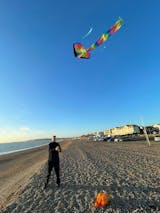Flying a kite can be a delightful and exhilarating experience, but getting it airborne isn't always as simple as it seems. We've all been there—running across the field, string in hand, only to watch our kite nosedive into the grass. Understanding the nuances of kite launching can make all the difference between a successful flight and a frustrating afternoon.
Key Takeaways
- Select the Right Kite: Choose a suitable kite based on wind conditions and experience level; diamond and delta kites are great for beginners.
- Assess Wind Conditions: Opt for gentle to moderate winds (8-24 km/h) and check local weather forecasts for optimal kite flying conditions.
- Choose an Open Location: Find a spacious, obstruction-free area like a park or beach for a smooth launch and increased safety.
- Assemble Properly: Follow instructions carefully to ensure all parts are secured and aligned correctly for successful kite launching.
- Use Proper Launch Techniques: Stand with your back to the wind, extend the line straight, and consider having an assistant to help with larger kites.
- Address Common Issues: Manage variable winds by gentle line adjustments and prevent tangles and crashes by flying in clear, open spaces.
Understanding the Basics of Kite Flying
Choosing the Right Kite
Selecting the appropriate kite is crucial for a successful launch. Different kites suit various wind conditions and user experience levels. Diamond kites and delta kites are ideal for beginners due to their stability and ease of control. For kites for children, it's best to choose those with simple designs and lightweight frames, as they require less skill to operate. Advanced flyers might opt for stunt kites, which offer more manoeuvrability.
Understanding Wind Conditions
Grasping wind conditions ensures a smoother flying experience. Gentle to moderate winds (8-24 km/h) are ideal for most kites. To assess wind strength, observe trees and flags: a gentle breeze sways leaves, while a moderate wind moves branches. Avoid flying in gusty or turbulent winds, as they can make controlling the kite difficult. Always check local weather forecasts before heading out to ensure optimal conditions for kite flying.
Understanding these basics helps us enjoy kite flying with minimal hassle and maximum fun.
Preparing for Kite Launching

Find a Suitable Location
Selecting the right location ensures a smooth kite-launch experience. Open spaces free from obstructions, such as parks or beaches, offer ideal conditions. Tall buildings, trees, and power lines can interfere with kite flying, posing safety risks. It's best to avoid crowded areas to prevent accidents. Locations with steady wind without turbulence are optimal. Although beaches provide perfect settings due to consistent breeze, parks with wide-open fields work too.
Assembling Your Kite Properly
Proper kite assembly is crucial for successful kite launching. Follow the instructions provided with the kite. Fix spars securely to maintain the kite's shape. For diamond and delta kites, ensure the spine and cross-spars are aligned correctly. Attach the kite line to the bridle, making sure knots are tight. Double-check all connections before flying. For kids kites, assist children with assembly to ensure safety and proper function. An incorrectly assembled kite can fail to launch or crash quickly. By taking time to assemble a kite properly, you increase your chances of a successful and enjoyable kite flying session.
Key Techniques for Launching Your Kite
Positioning and Handling the Kite
Positioning and handling the kite properly ensures a smooth launch. Start by standing with your back to the wind. This orientation lets the wind fill the kite's sail, making it easier to lift off. Hold the kite by its bridle point. If it's a kite for children, ensure they understand where to grip. Lay out the line in a straight line away from the direction of the wind, avoiding tangles.
The Importance of Assistance
Having assistance, especially when launching larger kites, simplifies the process. One person can hold the kite while the other manages the line. For kids’ kites, adult help is beneficial. The helper should hold the kite up and let go gently as the flyer pulls the line taut. Coordination between both parties makes the launch smoother, avoiding sudden jerks or crashes.
By following these key techniques, our kite flying experiences become more enjoyable and proficient.
Common Challenges and Solutions
Dealing With Variable Winds
Kite flying can be difficult in variable winds, with fluctuating speed and direction making control challenging. We suggest choosing kites with a broad wind range, such as delta and diamond kites, known for their stability. When the wind picks up, avoid rapid movements that could cause the kite to dive. Instead, make gentle adjustments to the line to manage minor turbulence. Lower the kite and wait for a more consistent breeze if the wind becomes too strong or irregular. Understanding local wind patterns through weather apps can help identify optimal times for launching your kite.
Managing Kite Tangles and Crashes
One common issue in kite flying is tangling lines. This problem is amplified when flying kids kites or kites for children, as they often lack the same control as adults. To prevent tangles, ensure lines are laid out straight before launch. If a tangle occurs, stop flying immediately and untangle the lines manually. Crashes tend to happen when kites dive suddenly due to irregular wind or a lack of control. Minimising the risk of crashes requires avoiding crowded or obstructed areas and launching in clear, open spaces. Always check for damage after a crash and make necessary repairs to prevent future issues.
Maintenance Tips Post-Launch
Cleaning and Storing Your Kite
Proper maintenance of your kite enhances its longevity and performance. Post-launch, start by cleaning the kite to remove dirt, sand, or salt water. Use a soft cloth dampened with water for this purpose. Avoid using harsh chemicals, which could damage the fabric or structure.
Once the kite's clean, ensure it's completely dry before storing. Moisture can lead to mould growth or fabric deterioration. Disassemble the kite carefully, following the manufacturer's instructions, to prevent any damage to the spars or fabric. Store the kite in a dry, cool place, ideally in the original packaging or a dedicated kite storage bag to protect it from dust and pests.
For kites for children, ensure all parts are accounted for and any minor damages are repaired before storage. This makes sure that the kite will be ready for the next flying session without requiring additional repairs.
Conclusion
Launching a kite can be a delightful and rewarding experience when we follow the right steps and take the necessary precautions. By selecting the appropriate kite for our skill level and understanding the wind conditions, we set ourselves up for success. It's essential to prepare thoroughly, from choosing a suitable location to properly assembling our kite.
Having a helper can make the process smoother, especially with larger kites. Overcoming common challenges like variable winds or tangles requires patience and practice. Post-launch, proper maintenance ensures our kite remains in top condition for future flights.
With these tips in mind, we're ready to enjoy the exhilarating experience of kite flying to its fullest.
Frequently Asked Questions
What type of kite is best for beginners?
Diamond and delta kites are ideal for beginners. They are easy to assemble, stable, and fly well in a variety of wind conditions.
How do I choose the right kite for windy conditions?
Choose a kite based on the wind speed and your experience. Beginners should start with diamond or delta kites in moderate winds (around 8-15 mph), while advanced flyers can opt for stunt kites in stronger winds.
Why is location important for kite flying?
A suitable location, clear of obstructions like trees and buildings, ensures a smooth, safe flying experience and reduces the risk of kite crashes and tangles.
How do I launch a kite successfully?
Position the kite facing the wind, hold it firmly, and either have an assistant help or step back while gradually releasing the line. Proper positioning and handling are crucial for a successful launch.
What can I do to handle gusty winds?
Avoid flying in gusty wind conditions as they can make kite flying challenging. Always check weather forecasts before heading out.
How should I handle a tangled or crashed kite?
Gently untangle the lines using your hands, avoiding any sharp objects that can damage the kite. If a crash occurs, inspect the kite for any damages and repair them promptly.
How do I maintain my kite after flying it?
Clean your kite with a soft cloth dampened with water to remove dirt, sand, and salt water. Ensure it is completely dry before storing to prevent mould or fabric deterioration.
What are proper storage practices for kites?
Disassemble the kite as per the manufacturer's instructions, and store it in a dry, cool place. Avoid moisture to prevent mould growth and ensure longevity.




